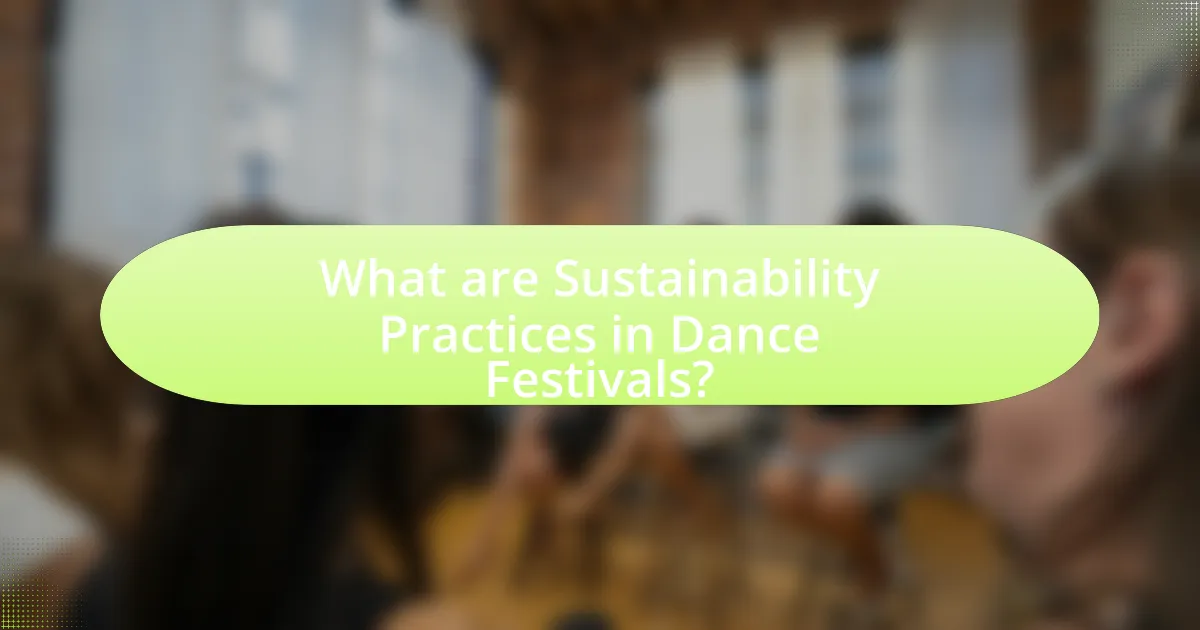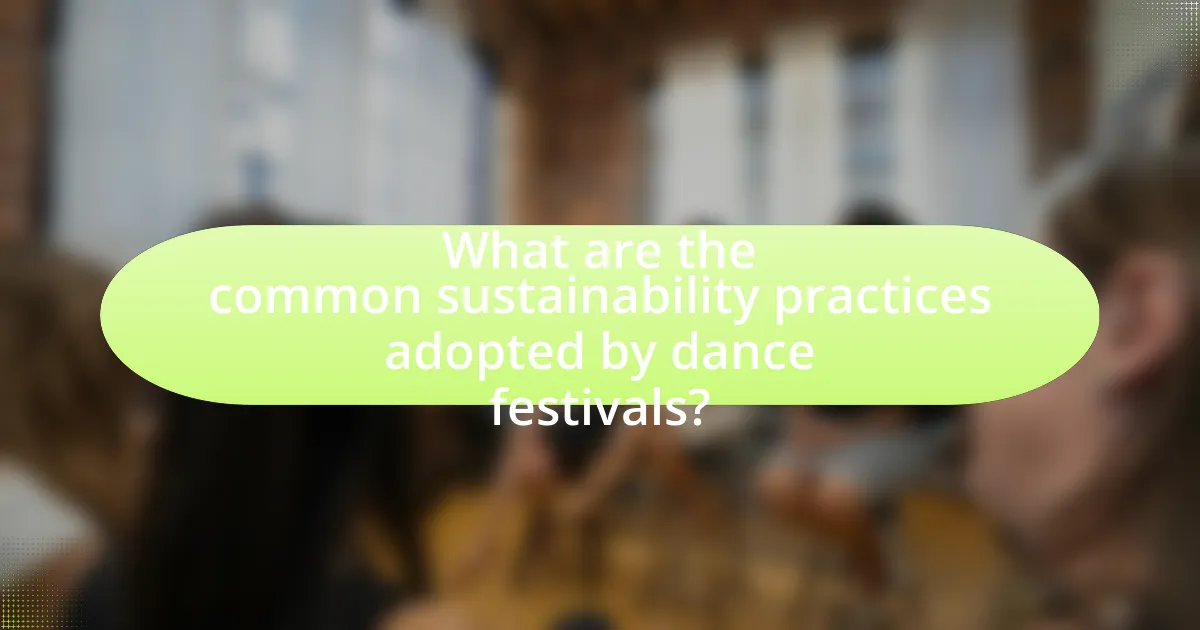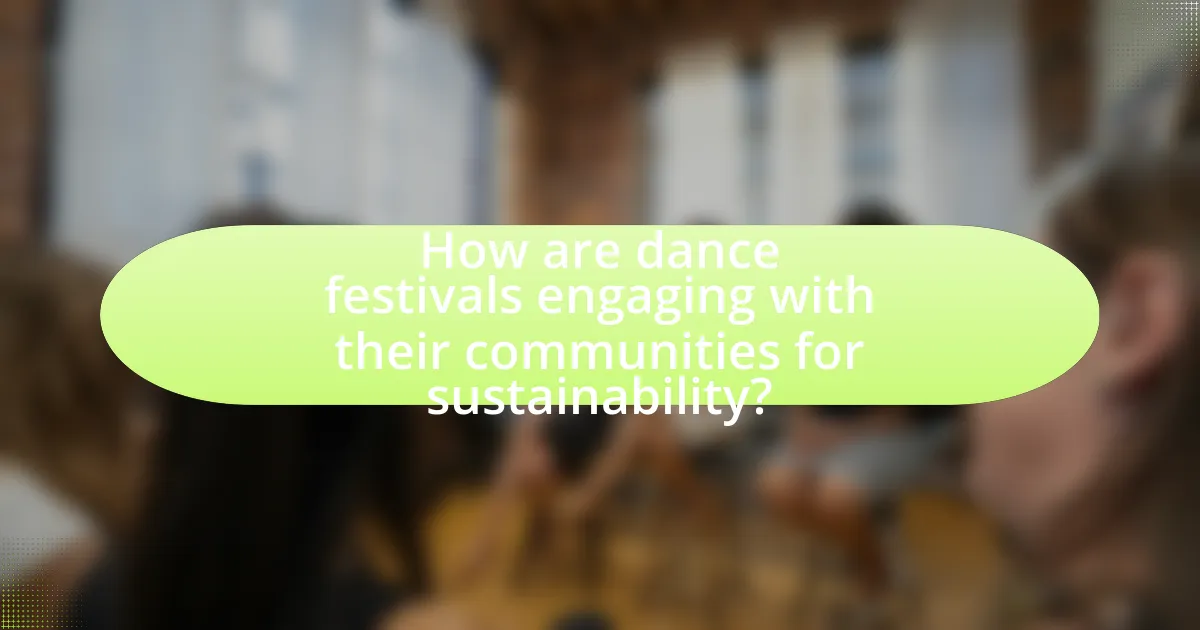Sustainability practices in dance festivals focus on minimizing environmental impact through waste reduction, energy efficiency, and community engagement. Key principles include reducing ecological footprints, promoting social equity, and ensuring economic viability. Festivals implement strategies such as recycling, composting, and utilizing renewable energy sources to enhance sustainability. Additionally, community involvement and partnerships with local businesses play a crucial role in fostering eco-friendly practices. The article explores the importance of sustainability in dance festivals, the challenges faced, and future trends, providing insights into effective strategies for creating greener events.

What are Sustainability Practices in Dance Festivals?
Sustainability practices in dance festivals include waste reduction, energy efficiency, and community engagement. These practices aim to minimize the environmental impact of events while promoting social responsibility. For instance, many festivals implement recycling and composting programs to divert waste from landfills, with some achieving over 70% waste diversion rates. Additionally, the use of renewable energy sources, such as solar panels, helps reduce carbon footprints. Community engagement initiatives, such as local sourcing of food and materials, foster economic support for nearby businesses and enhance the festival’s connection to its locale. These practices collectively contribute to a more sustainable event model in the dance festival industry.
How do dance festivals define sustainability?
Dance festivals define sustainability as the integration of environmentally responsible practices into their operations, aiming to minimize ecological impact while promoting social and economic benefits. This includes initiatives such as waste reduction, energy efficiency, and the use of renewable resources. For instance, many festivals implement recycling programs, utilize solar energy, and encourage attendees to use public transportation, thereby reducing carbon footprints. These practices not only contribute to environmental preservation but also foster community engagement and support local economies, demonstrating a holistic approach to sustainability in the festival context.
What are the key principles of sustainability in event management?
The key principles of sustainability in event management include reducing environmental impact, promoting social equity, and ensuring economic viability. Reducing environmental impact involves minimizing waste, conserving energy, and using sustainable materials, which can be evidenced by the implementation of recycling programs and energy-efficient technologies at events. Promoting social equity focuses on inclusivity and community engagement, ensuring that events benefit local populations and respect cultural diversity. Ensuring economic viability means creating financially sustainable events that can support local economies while maintaining affordability for attendees. These principles collectively guide event organizers in creating responsible and sustainable experiences.
How do these principles apply specifically to dance festivals?
Sustainability principles apply to dance festivals by promoting eco-friendly practices that minimize environmental impact. For instance, many dance festivals implement waste reduction strategies, such as using biodegradable materials and encouraging recycling, which significantly lowers landfill contributions. Additionally, festivals often prioritize local sourcing of food and materials, reducing carbon footprints associated with transportation. According to a study by the University of California, events that adopt sustainable practices can reduce their overall waste by up to 50%. Furthermore, energy-efficient technologies, such as solar-powered stages and LED lighting, are increasingly utilized, demonstrating a commitment to reducing energy consumption. These practices not only enhance the festival experience but also contribute to broader environmental goals.
Why is sustainability important for dance festivals?
Sustainability is important for dance festivals because it minimizes environmental impact and promotes social responsibility. Dance festivals often generate significant waste, consume large amounts of energy, and can disrupt local ecosystems. Implementing sustainable practices, such as waste reduction, renewable energy use, and eco-friendly transportation options, helps mitigate these effects. For instance, a study by the Green Music Initiative found that festivals adopting sustainable measures can reduce their carbon footprint by up to 50%. This not only benefits the environment but also enhances the festival’s reputation, attracting eco-conscious attendees and sponsors.
What environmental impacts do dance festivals have?
Dance festivals have significant environmental impacts, primarily through waste generation, energy consumption, and land use. These events often produce large amounts of waste, with studies indicating that festivals can generate up to 1,000 tons of waste over a weekend, much of which is not recycled. Energy consumption is another critical factor, as festivals typically rely on fossil fuels for power, contributing to greenhouse gas emissions. Additionally, the land use for staging these festivals can lead to habitat disruption and soil degradation, particularly in natural settings. For instance, a report by the UK-based Festival Industry Green Initiative highlighted that outdoor festivals can cause long-term ecological damage if not managed sustainably.
How can sustainable practices mitigate these impacts?
Sustainable practices can mitigate the environmental impacts of dance festivals by reducing waste, conserving resources, and minimizing carbon footprints. Implementing strategies such as waste segregation, composting, and recycling can significantly decrease landfill contributions; for instance, festivals that adopt zero-waste policies have reported waste diversion rates exceeding 90%. Additionally, utilizing renewable energy sources, such as solar panels, can lower greenhouse gas emissions associated with energy consumption. Research from the Green Music Initiative indicates that festivals using renewable energy can reduce their carbon footprint by up to 50%. Furthermore, promoting sustainable transportation options, like carpooling and public transit, can decrease traffic congestion and emissions. Overall, these practices not only lessen the ecological footprint of dance festivals but also foster a culture of sustainability among attendees.

What are the common sustainability practices adopted by dance festivals?
Common sustainability practices adopted by dance festivals include waste reduction, energy efficiency, and sustainable transportation. Dance festivals often implement recycling and composting programs to minimize waste, with some events achieving over 70% waste diversion rates. Additionally, many festivals utilize renewable energy sources, such as solar panels, to power stages and facilities, reducing their carbon footprint. Sustainable transportation initiatives, such as promoting public transit, carpooling, and providing bike parking, further contribute to lowering emissions associated with attendee travel. These practices reflect a growing commitment within the dance festival community to environmental stewardship and sustainability.
How do dance festivals reduce waste?
Dance festivals reduce waste through comprehensive waste management strategies, including recycling programs, composting initiatives, and the use of biodegradable materials. These festivals often implement on-site recycling stations to encourage attendees to separate waste effectively, which can lead to a significant reduction in landfill contributions. For example, the Electric Forest Festival reported diverting over 80% of its waste from landfills through such initiatives. Additionally, many festivals partner with local organizations to ensure that food waste is composted, further minimizing environmental impact. By promoting reusable items, such as water bottles and utensils, dance festivals also decrease single-use plastic consumption, contributing to overall waste reduction.
What strategies are used for waste management and recycling?
Effective strategies for waste management and recycling in dance festivals include source separation, composting, and the use of biodegradable materials. Source separation involves categorizing waste at the point of disposal, allowing for easier recycling and composting. Composting transforms organic waste into nutrient-rich soil, reducing landfill contributions. Additionally, utilizing biodegradable materials minimizes environmental impact, as these materials break down naturally. According to a study by the Environmental Protection Agency, implementing these strategies can lead to a 30% reduction in waste generation at large events.
How do festivals encourage attendees to minimize waste?
Festivals encourage attendees to minimize waste through initiatives such as providing reusable containers, implementing recycling programs, and offering educational workshops on sustainability. By distributing reusable cups and plates, festivals reduce single-use plastics, which are a significant contributor to waste. Additionally, many festivals set up clearly marked recycling and composting stations, making it easier for attendees to dispose of their waste responsibly. Educational workshops often inform attendees about the environmental impact of waste and promote sustainable practices, reinforcing the importance of minimizing waste during the event. These strategies collectively contribute to a culture of sustainability at festivals, leading to reduced environmental footprints.
What role does energy efficiency play in dance festivals?
Energy efficiency plays a crucial role in dance festivals by reducing energy consumption and minimizing environmental impact. Implementing energy-efficient practices, such as using LED lighting and energy-efficient sound systems, can significantly lower the carbon footprint of these events. For instance, a study by the Green Music Initiative found that festivals adopting energy-efficient technologies can reduce energy use by up to 50%, demonstrating a tangible commitment to sustainability. Additionally, energy efficiency not only conserves resources but also lowers operational costs, allowing festival organizers to allocate funds to other sustainable initiatives.
What renewable energy sources are commonly utilized?
Commonly utilized renewable energy sources include solar, wind, hydroelectric, geothermal, and biomass energy. Solar energy harnesses sunlight through photovoltaic cells, making it a popular choice for outdoor events like dance festivals. Wind energy captures kinetic energy from wind using turbines, providing a sustainable power source. Hydroelectric energy generates electricity from flowing water, often used in locations near rivers or dams. Geothermal energy taps into the Earth’s internal heat, offering a reliable energy source in volcanic regions. Biomass energy converts organic materials into fuel, contributing to waste reduction and energy production. These sources are increasingly adopted in dance festivals to minimize environmental impact and promote sustainability.
How do festivals implement energy-saving technologies?
Festivals implement energy-saving technologies by utilizing renewable energy sources, such as solar panels and wind turbines, to power their events. For instance, many festivals install solar-powered lighting and sound systems, which significantly reduce reliance on fossil fuels. Additionally, festivals often incorporate energy-efficient LED lighting and smart grid technology to optimize energy consumption. According to a report by the Green Festival Alliance, events that adopt these technologies can reduce their carbon footprint by up to 50%. This demonstrates that the integration of energy-saving technologies not only supports sustainability but also enhances the overall efficiency of festival operations.

How are dance festivals engaging with their communities for sustainability?
Dance festivals are engaging with their communities for sustainability by implementing local partnerships, promoting eco-friendly practices, and fostering community involvement in environmental initiatives. For instance, many festivals collaborate with local organizations to reduce waste through recycling and composting programs, which not only minimizes their ecological footprint but also educates attendees on sustainable practices. Additionally, festivals often feature local artists and vendors, supporting the local economy while encouraging sustainable sourcing of materials. Research indicates that festivals that actively involve their communities in sustainability efforts see increased participation and awareness, demonstrating a collective commitment to environmental stewardship.
What partnerships are formed to promote sustainability?
Partnerships formed to promote sustainability in dance festivals include collaborations between event organizers, local governments, environmental NGOs, and corporate sponsors focused on sustainable practices. For instance, festivals often partner with organizations like the Green Music Initiative, which provides guidelines for reducing environmental impact, and local waste management services to implement recycling and composting programs. These partnerships are essential for creating a comprehensive sustainability strategy, as they leverage resources and expertise from various sectors to minimize carbon footprints and promote eco-friendly practices.
How do local businesses contribute to sustainable practices?
Local businesses contribute to sustainable practices by implementing eco-friendly operations, sourcing materials locally, and promoting community engagement. These businesses often adopt sustainable practices such as reducing waste, using renewable energy, and minimizing carbon footprints, which collectively support environmental conservation. For instance, a study by the American Independent Business Alliance found that local businesses are more likely to support sustainable practices compared to larger corporations, as they prioritize community well-being and environmental stewardship. Additionally, local businesses frequently collaborate with local suppliers, reducing transportation emissions and fostering a circular economy within their communities.
What community initiatives are supported by dance festivals?
Dance festivals support various community initiatives, including local economic development, cultural exchange, and environmental sustainability. These festivals often collaborate with local businesses to boost tourism and create job opportunities, thereby enhancing the economic landscape of the community. Additionally, they promote cultural exchange by showcasing diverse dance forms and fostering inclusivity among different cultural groups. Furthermore, many dance festivals implement eco-friendly practices, such as waste reduction and sustainable resource management, to minimize their environmental impact, aligning with broader sustainability goals. For instance, the Green Festival initiative has been adopted by several dance events to encourage recycling and reduce carbon footprints, demonstrating a commitment to both community welfare and environmental stewardship.
How do festivals educate attendees about sustainability?
Festivals educate attendees about sustainability through workshops, informational booths, and interactive activities that promote eco-friendly practices. These events often feature sessions led by sustainability experts who provide insights on topics such as waste reduction, renewable energy, and sustainable transportation. For instance, the Glastonbury Festival has implemented a “Green Policy” that includes educational initiatives aimed at reducing plastic waste and encouraging recycling, which has resulted in a significant decrease in single-use plastics at the event. Additionally, many festivals collaborate with environmental organizations to raise awareness about climate change and conservation efforts, further enhancing attendees’ understanding of sustainability.
What programs or workshops are offered to promote awareness?
Dance festivals often offer programs and workshops focused on sustainability awareness, such as “Eco-Friendly Dance Practices,” “Sustainable Event Management,” and “Waste Reduction Strategies.” These initiatives educate participants on minimizing environmental impact through practical techniques and strategies. For instance, the “Eco-Friendly Dance Practices” workshop teaches artists how to incorporate sustainable materials and methods into their performances, while “Sustainable Event Management” provides insights into organizing eco-conscious events. Such programs are essential for fostering a culture of sustainability within the dance community, as evidenced by the increasing number of festivals implementing these practices to reduce their carbon footprint and promote environmental responsibility.
How do festivals use social media to spread sustainability messages?
Festivals use social media to spread sustainability messages by creating engaging content that highlights their eco-friendly initiatives and encourages audience participation. For example, festivals often share posts about waste reduction, recycling programs, and sustainable transportation options, which can reach thousands of followers instantly. Additionally, they utilize hashtags related to sustainability to increase visibility and foster community discussions around green practices. Research indicates that social media campaigns can significantly enhance public awareness and participation in sustainability efforts, as seen in events like the Glastonbury Festival, which reported a 50% reduction in single-use plastics due to their social media outreach.
What are the challenges faced in implementing sustainability practices?
The challenges faced in implementing sustainability practices include financial constraints, lack of stakeholder engagement, and insufficient infrastructure. Financial constraints often limit the ability of dance festivals to invest in sustainable technologies and practices, as many events operate on tight budgets. Lack of stakeholder engagement can hinder the adoption of sustainability initiatives, as not all participants may prioritize or understand the importance of these practices. Additionally, insufficient infrastructure, such as inadequate waste management systems and limited access to renewable energy sources, poses significant barriers to effectively implementing sustainability measures at dance festivals. These challenges are documented in studies highlighting the complexities of integrating sustainability into large-scale events, emphasizing the need for comprehensive planning and collaboration among all stakeholders involved.
What financial barriers do festivals encounter?
Festivals encounter several financial barriers, including high operational costs, fluctuating sponsorship revenues, and limited ticket sales. High operational costs arise from venue rentals, artist fees, and logistical expenses, which can strain budgets. Fluctuating sponsorship revenues are often influenced by economic conditions and brand priorities, making it challenging for festivals to secure consistent funding. Limited ticket sales can occur due to competition, market saturation, or economic downturns, further impacting financial viability. These barriers can hinder the ability of festivals to implement sustainable practices, as financial constraints may prioritize immediate operational needs over long-term environmental initiatives.
How do logistical issues affect sustainability efforts?
Logistical issues significantly hinder sustainability efforts by creating inefficiencies in resource management and increasing carbon footprints. For instance, inadequate transportation planning can lead to higher fuel consumption and emissions, as seen in events where organizers fail to optimize routes for waste disposal and material delivery. Additionally, poor coordination among vendors can result in excess waste, as seen in festivals that do not effectively manage food and beverage supplies, leading to overproduction and disposal of unused items. These logistical challenges directly contradict sustainability goals, which aim to minimize environmental impact and promote efficient resource use.
What are the future trends in sustainability for dance festivals?
Future trends in sustainability for dance festivals include increased use of renewable energy sources, enhanced waste management practices, and a focus on local sourcing of food and materials. Dance festivals are increasingly adopting solar and wind energy to power their events, reducing reliance on fossil fuels. Additionally, many festivals are implementing comprehensive recycling and composting programs to minimize waste, with some aiming for zero waste by diverting over 90% of their waste from landfills. Furthermore, sourcing food and materials locally not only supports regional economies but also reduces carbon footprints associated with transportation. These trends are supported by the growing demand for eco-friendly practices among festival-goers, as evidenced by surveys indicating that over 70% of attendees prefer events that prioritize sustainability.
How are technological advancements shaping sustainable practices?
Technological advancements are significantly shaping sustainable practices by enabling more efficient resource management and reducing environmental impact. For instance, innovations in renewable energy technologies, such as solar and wind power, allow dance festivals to operate with minimal reliance on fossil fuels, thereby decreasing carbon emissions. Additionally, advancements in waste management technologies, including smart recycling systems and composting solutions, facilitate better waste segregation and reduction at events. According to a report by the International Energy Agency, the use of renewable energy sources in large events can cut greenhouse gas emissions by up to 70%. Furthermore, digital ticketing and cashless payment systems reduce paper waste and streamline operations, contributing to overall sustainability goals.
What innovations are emerging in the festival industry?
Innovations emerging in the festival industry include the implementation of sustainable technologies, such as solar-powered stages and waste-to-energy systems. These advancements aim to reduce the environmental impact of festivals. For instance, festivals like Coachella have adopted solar energy solutions, significantly decreasing their carbon footprint. Additionally, the use of biodegradable materials for food packaging and eco-friendly merchandise is becoming more prevalent, as seen in events like Glastonbury, which has committed to reducing single-use plastics. These innovations not only enhance sustainability but also attract environmentally conscious attendees, reflecting a growing trend in the festival landscape.
What practical tips can dance festivals adopt for going green?
Dance festivals can adopt several practical tips for going green, including implementing waste reduction strategies, utilizing renewable energy sources, and promoting sustainable transportation options. For instance, festivals can minimize waste by providing recycling and composting stations, which can lead to a significant reduction in landfill contributions; a study by the Green Music Initiative found that festivals implementing such measures reduced waste by up to 50%. Additionally, using solar panels or wind turbines for energy needs can decrease reliance on fossil fuels, as demonstrated by the Coachella Valley Music and Arts Festival, which has incorporated solar energy to power its operations. Lastly, encouraging attendees to use public transport, carpool, or bike to the event can lower carbon emissions, with the UK’s Festival Republic reporting that promoting sustainable travel options resulted in a 20% decrease in festival-related transport emissions.
How can festivals effectively measure their sustainability impact?
Festivals can effectively measure their sustainability impact by utilizing a combination of quantitative metrics and qualitative assessments. These metrics include tracking carbon emissions, waste generation, water usage, and energy consumption, which can be quantified through tools like carbon calculators and waste audits. For instance, a study by the Green Music Initiative found that festivals can reduce their carbon footprint by up to 50% by implementing effective waste management and energy efficiency practices. Additionally, gathering feedback from attendees regarding their perceptions of sustainability efforts can provide valuable qualitative data. This dual approach of combining hard data with attendee insights allows festivals to comprehensively assess their sustainability impact and identify areas for improvement.
What best practices can be shared among festival organizers?
Festival organizers can share best practices such as implementing waste reduction strategies, promoting sustainable transportation, and engaging local communities. Waste reduction strategies include using biodegradable materials and establishing recycling programs, which can significantly decrease landfill contributions; for instance, the Glastonbury Festival reported a 50% reduction in waste through such initiatives. Promoting sustainable transportation involves encouraging attendees to use public transport or carpooling, which can lower carbon emissions; the Electric Forest Festival successfully incentivized this by providing shuttle services. Engaging local communities fosters support and collaboration, enhancing the festival’s cultural relevance and economic impact; the Coachella Valley Music and Arts Festival has effectively partnered with local businesses to create a mutually beneficial relationship. These practices not only enhance sustainability but also improve the overall festival experience.
